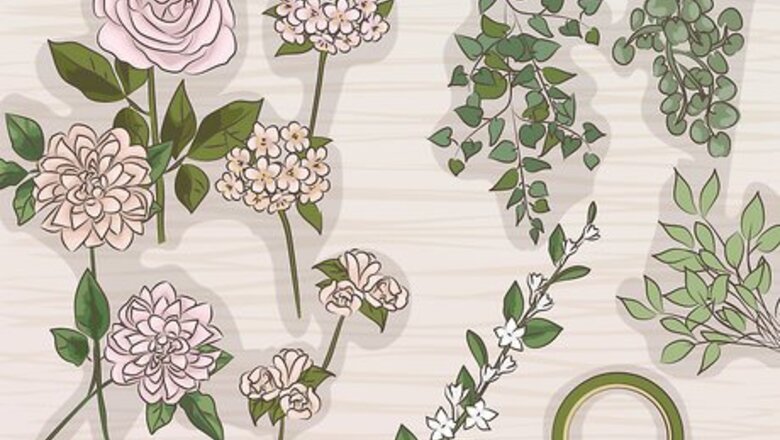
views
Assembling a Hand-Tied Cascade Bouquet
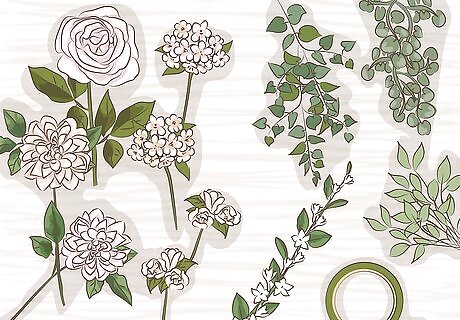
Select 1-3 large blooms, 4-6 smaller flowers, and 4-6 pieces of greenery. The hand-tied cascade is a large and dramatic arrangement of loosely bunched flowers and trailing greenery. Purchase flowers and greenery of a variety of sizes and shapes that fit the color scheme you have chosen for your wedding. Also gather floral tape, wire and any embellishments you’d like to include, such as ribbon, fabric, berries, etc. Selections of larger blooms, like roses, peonies, or calla lilies, mixed in with smaller, hanging bunches, like baby’s breath or jasmine, provide textural interest along with sprigs of long, trailing greenery. Look for flowers that come as single stems, with wire that runs the length of the stem and into the leaves, and a matte finish. These will look more realistic and be easier to work with. Read reviews online to learn more about the strengths and weaknesses of different faux flower designers. Go with high-end artificial flowers if you can since they'll look more realistic than cheaper artificial flowers.
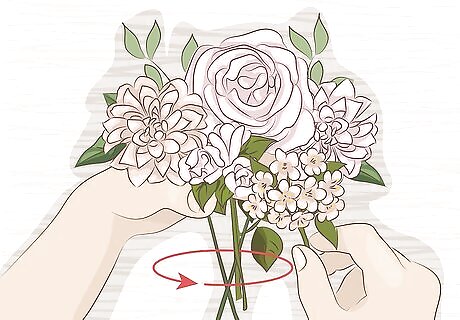
Layer the stems in your hand. Begin with the focal point blooms that you want to sit in the center of the bouquet. Build out from this nucleus in layered circles, rotating the bouquet as you build it, placing smaller blooms towards the outside. Insert greenery in between blooms to create space and help the blossoms pop. Add in additional elements like berries as you go. If desired, add ribbons or bows into your bouquet as you build it by attaching them with floral tape to the stems of individual blooms.
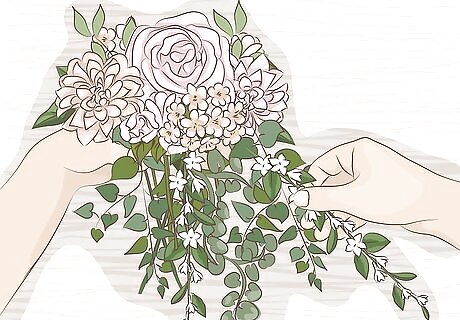
Create the cascade effect with long blooms and trailing greenery. Pieces like jasmine, eucalyptus, trailing ivy, olive branches, or honey suckle can be added to the bottom front of the bouquet. This will build the long green flowing base of your cascade. Stop and rearrange if things aren’t turning out. You have complete control in how you build your cascade. Allow your flowers to flow outwards, bending them if necessary, so that the arrangement does not remain too tightly packed. Add bright, noticeable blooms into your greenery cascade, as though they are spilling out from the center of the bouquet. Longer stem blooms, like roses, work well for this.
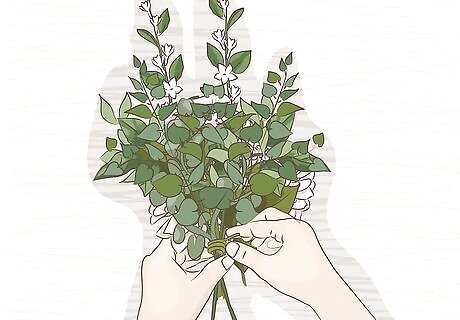
Secure the bouquet with wire. Cut 6–8 in (15–20 cm) of floral wire with your wire cutters. Wrap it several times around the stems just below the blooms before twisting the ends together. Trim the twisted ends of the wire to 1 in (2.5 cm) in length and then tuck them into the stems. Pull the wire tightly enough to keep the stems fixed in place.
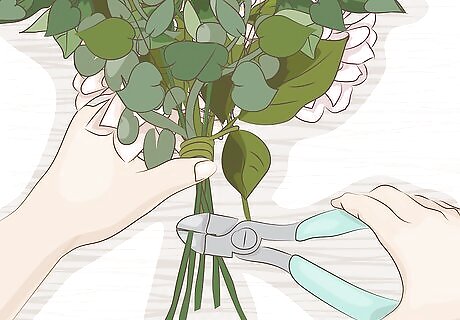
Cut your stems to an even length. Use your wire cutters to trim the stems to the desired length, evening them out as you go. You want the stems to be long enough for you to comfortably grip them, but not so long that they are very visible. About 7–8 in (18–20 cm) is a good length for most brides. When trimming, err on the side of leaving them too long. Go back and remove more of the stems later, if necessary.
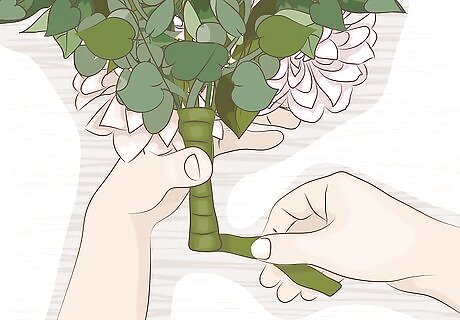
Wrap the stems together with floral tape. Take one end of your floral tape and begin wrapping it around the stems at the base of the flowers, covering the wire and stems completely. Work your way around and down the stems. Tear the tape and tuck the loose end into itself when you get at least 2–3 in (5.1–7.6 cm) down the length of the stem. The floral tape helps stabilize the bouquet, hides the stems, and provides a nice handle to hold onto. Continue wrapping all the way down to cover the ends of your stems, if desired.
Building a Round Bouquet

Select 1-2 large blooms and 4-6 smaller flowers. For a formal mid-size bouquet, consider the round arrangement. This globe-shaped bouquet is created by bunching similarly shaped and colored blooms tightly together. You can also make them all one flower type if you desire a uniform, formal look. Select 4-6 pieces of greenery or other accents to place in between the blooms, if desired. Larger blooms, like roses, tulips, hydrangeas, or peonies work well in the round bouquet. Flowers made from polyester and plastic are cheaper to make and thus are less costly and more widely available. Polyester or rayon flowers come in a wide range of colors, sizes, and types but they may not always look as realistic up close. Silk or cotton flowers are generally more expensive, higher-quality alternatives. They often come in single stems only and tend to look more realistic.
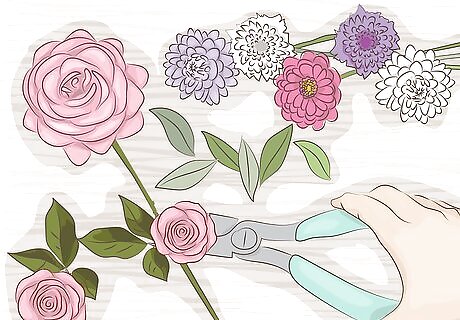
Cut apart bunches and remove the leaves. If your flowers came as a bunch, cut them into individual pieces using your wire cutters. Remove the leaves from the stems by pulling them off or using scissors. For a fuller bouquet with greenery, leave the leaves at the base of the bloom on the stem.
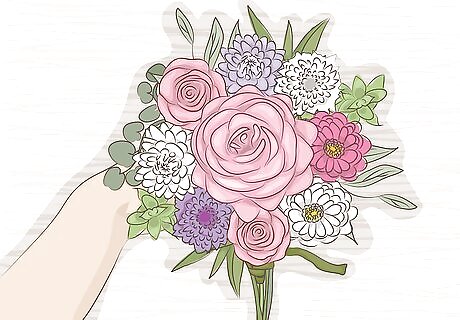
Build circular layers from the center outwards. Start by bunching together the 3-4 largest flowers to build a nucleus for your bouquet. Tape these together with 3-4 wraps of floral tape at the base of the blooms. Rotate the bouquet in your hand as you add additional blooms, building it in concentric, outward circles until it reaches the size you want. Attach each stem individually to the main stems of the bouquet by wrapping it several times near the base of the blooms. One design option while building your bouquet is to use different colors or blooms in each layer of the circle to create a distinctive and formal look. Consider a layered look with white roses at the center and red tulips in the outer circle, for example. Wrapping each stem as you go helps give you the signature round bouquet look of tightly-bunched flowers shaped into a dome or partial sphere.
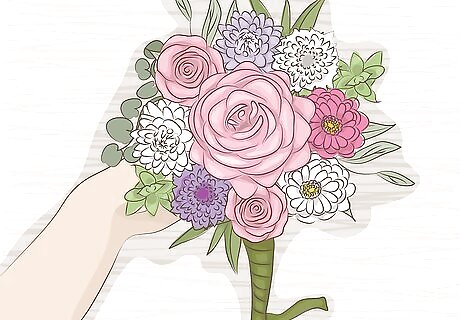
Tape all your stems together. Wrap from the base downward with your floral tape. Starting at the top of your stems, just underneath the blooms, wrap the bouquet with tape. Continue wrapping as you move towards the bottom of the stems until you are about 2–3 in (5.1–7.6 cm) down the length of the stems. You can tear the tape or cut it using scissors. Tuck the end of the tape underneath itself to hide the edges.
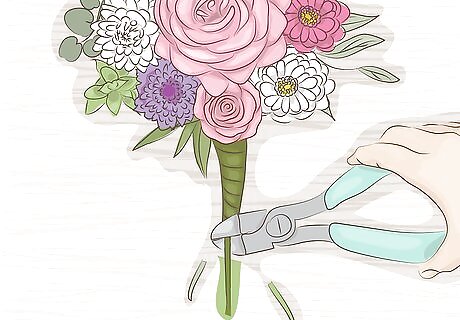
Cut your stems to an even length. Use your wire cutters to trim the stems to the desired length, evening them out as you go. You want the stems to be long enough for you to comfortably grip them, but not so long that they are very visible. About 7–8 in (18–20 cm) is a good length for most brides. When trimming, err on the side of leaving them too long. Go back and remove more of the stems later, if necessary.
Making a Pomander Bouquet

Select 1 large bloom variety and 1-2 smaller types. The pomander is an uncommon and eye-catching ball of blooms that is worn or carried from a small decorative loop of ribbon, twine, or rope. Select 1 flower type as the main bloom. If desired, choose 1-2 types of accent flowers, berries, greenery, or other decorations, to help accentuate the main flower blossoms. Roses work well in this arrangement, as do dahlias or chrysanthemums. Because these arrangements are tightly packed, you may need as many as 36 medium-sized flowers, like roses, to complete a bouquet. When evaluating flowers for purchase, look for visible seams, exposed wire, or other giveaways that call attention to the fact that they are artificial. If ordering online, order one of each flower you’re considering and try it out before you buy more.

Cut your flower arrangement foam into a rounded cube. This will be the center of your bouquet. If the foam came in a large block, cut it into a cube that is roughly 4–6 in (10–15 cm) all around. Shave off the edges to give it a more rounded shape. Keep in mind that once you add the flowers, it will look about two or three times as big as this foam core. Begin with a piece of foam that is about the size of your two fists together. You can skip this step if you buy a pre-formed foam sphere at a craft store or online.
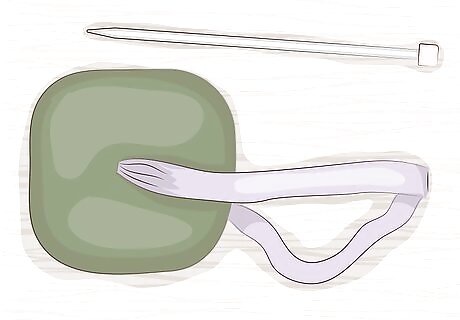
Attach the ribbon you will use to carry it. Use a chopstick, bbq skewer, knitting needle, or some other long pointy tool of your choosing to poke a thin hole through the center of your foam. Fold your ribbon in half and use your stick to thread it, folded side first, through the hole. Grab the folded end and pull it gently until it hangs out of the foam by about 1 in (2.5 cm). Tie a strong knot in the loose ends and then pull the folded side of the ribbon all the way through. Cut a piece of ribbon that will be the length you want after doubling it and running it through the middle of your sphere. For example, if you want a 12 in (30 cm) drop, cut 36 in (91 cm) of ribbon. Shorten the loop later if necessary, by wrapping it around your wrist or cutting it and tying it into a bow at the desired length.

Wrap the foam core with sheet moss. Holding the foam core in one hand, slowly wrap it in the moss. Use floral pins to hold the moss in place. This does not have to look perfect as you will be covering it with flowers, but make sure that most of the foam is covered. Spray the ball with hairspray to hold the moss in place. When you are finished, you should have what looks like a spherical ball of moss that will be the base for your bouquet.
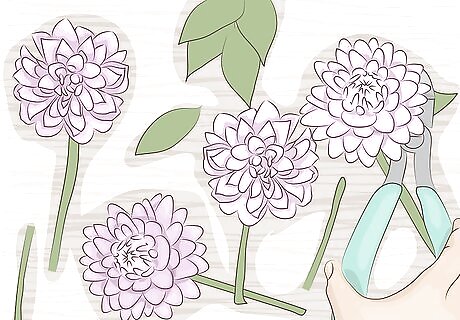
Strip leaves and cut your stems. Pull the leaves off or cut them with scissors. Use your wire cutters to cut stems to a length of about 2–3 in (5.1–7.6 cm), but don’t worry about making them all perfect. Adjust them in the foam as you place them. For a clean and more formal look, remove all the leaves so that only the blossoms remain. Push a few leaves up next to the blossom if you want to keep some of the greenery in your bouquet.
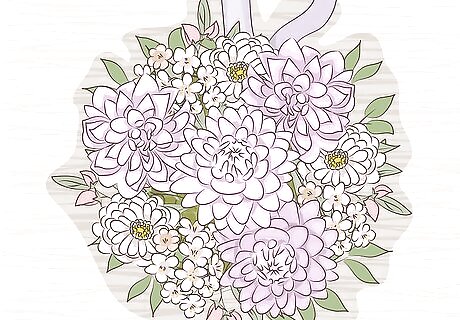
Stick the flowers into the moss-covered foam core. Insert the wire stems of your flowers into the foam. Push them in until they reach the desired height. Place all the largest flowers first, spacing them evenly around the sphere. Fill in any gaps as desired with additional flowers, greenery, or other embellishments. Continue until the entire ball is completely filled with flowers. Either push all the way up to the base of the flower for a tight look or leave them sticking out by 1–2 in (2.5–5.1 cm). Add a dab of white or hot glue onto the stem or directly to the foam center before you place it to add more stability.
Adding Embellishment and Finishing Touches
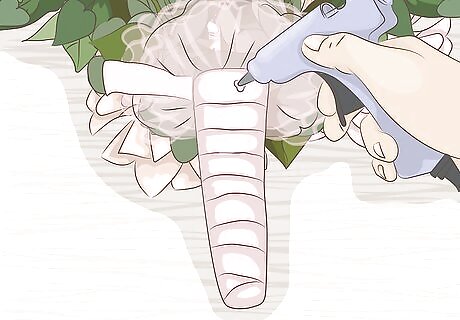
Wrap visible stems with ribbon or fabric for a polished look. Use a dab of hot glue to stick one end of the ribbon or fabric strip at the bottom of your stems and then wind it around, moving upwards. Avoid leaving gaps as you wrap. Cover the stems until you reach the base of the blooms. Cut the ribbon and attach it with a dab of glue or secure it with a decorative pin. Artificial flowers may not always have realistic looking stems, so wrapping the finished bouquet with a decorative ribbon or fabric is a good idea. Add decorative lace, pins or beading to your wrapped stems for a personalized look.
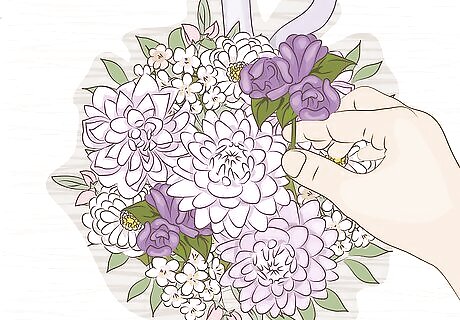
Complete your look with non-floral elements. Whether it’s tucking in additional greenery or adding sprigs of berries, beads, or feathers, think creatively about your final design. Attach a frame of greenery around the outside of your round or cascade bouquet by taping the additional stems to the existing bouquet. Insert greenery, feathers, ribbons or beads by sticking them into the tied stem of the round or cascade bouquet. Fill in gaps in your pomander by sticking additional flowers, sprigs of dried or fake berries, or greens into the spaces around your flowers. Make your bouquet your own with materials that uniquely represent you. Some unique and non-traditional elements might include LEGOS, tiny gears (for a steampunk fan), paintbrushes, circuit board elements, or colored pencils.

Spray with glitter or floral scents. A finishing spray that adds some sparkle or even some floral scents can help add the final touches to your bouquet. Place the bouquet on a flat surface and, holding the spray 10–12 in (25–30 cm) away from it, dust it lightly with floral glitter spray. Do the same for any scent you’d like to use, whether it’s lavender mist or your favorite perfume. Just because you have used artificial flowers doesn’t mean they can’t smell nice!











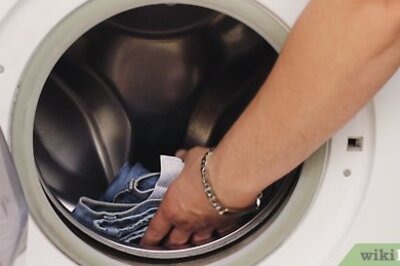








Comments
0 comment